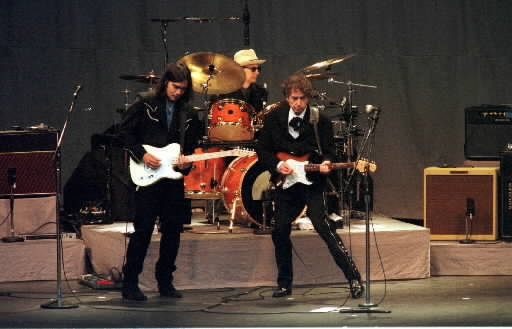 Bob Dylan is 65 today.
Bob Dylan is 65 today.I've seen Dylan live a few times: in London, Earl's Court, about fifteen years ago; in Manchester, the MEN Arena, about four years ago; and most recently in Vancouver, the Orpheum, just last year.
Each time there's been something unimpressive about these shows. Dylan refuses the spectacle more than any other musician I've seen. No doubt others refuse it more: The Jesus and Mary Chain, for instance, used to be notorious for playing sets sometimes only ten minutes long with their backs to the audience. At the same time, in both cases, this refusal is part of these performers' mystique: the fact that they refuse to perform is what makes their performances stand out. Put another way, they perform refusal.
In Dylan's Vancouver show, he and his band were arranged in a rough semi-circle around the stage. At the center of this semi-circle, and so front and center of the stage, was a microphone on a stand. One expected and hoped that at any moment Dylan would break formation from his backing singers, and come to the microphone. But though he did enter the semi-circle a couple of times, this was mainly for his harmonica solos, and the stand at the front remained an empty site of non-performance.
No doubt part of the point is also the notion that there is no distinction between Dylan and his band. Indeed, he seems to want us to believe that we are simply eavesdropping onto some kind of jam in which a few friends are laying back and playing some riffs. Not that there's much all that laid back about (what I'll continue to call) the show: everything was up tempo, with scarcely a break between songs, each of which came to sound increasingly similar. It was as though we were witnessing one long medley of Dylan cover versions.
"Witnessing" is probably the best description of the subject position that Dylan appears to want for his audience. Neither spectator nor participant, we seem to be there but strangely not quite there in his mind. Only the most minimal gestures (a slight wave of the harmonica after a solo) are overt signs that he even notices our presence.
There's something attractive, almost seductive about such reticence. But it is of course all in immensely bad faith. There's no doubt that Dylan is the star, however much he may wish to deny it. And we are indeed spectators: spectators of a performance of a very particular type.
It's been some thirty five years since David Bowie articulated Dylan's relationship with his public (the public?) as one of abandonment or betrayal:
Now hear this Robert ZimmermanThis was after Dylan's famous withdrawal, following his 1966 motorcycle accident. It's no great coincidence that the recent fuss around Dylan (the Scorcese documentary with its accompanying CD and book, "Bob Dylan's American Journey" at Seattle's EMP, even Bob's own Chronicles, however coy) has centered around this pre-1966 period. It's as though we were seeking to reconnect, to bring Dylan back. And so ironically to bring back a presumed "unity" even from the social divisiveness of the 1960s protest movements with which the early Dylan was so associated.
Though I don't suppose we'll meet
Ask your good friend Dylan
If he'd gaze a while down the old street
Tell him we've lost his poems
So they're writing on the walls
Give us back our unity
Give us back our family
You're every nation's refugee
Don't leave us with their sanity
("Song for Bob Dylan")
But the real truth of Dylan is in this betrayal, this reticence, a sort of mutiny from above which may even have begun before 1966, but is now ensconced and strangely celebrated in the "never-ending tour".

No comments:
Post a Comment